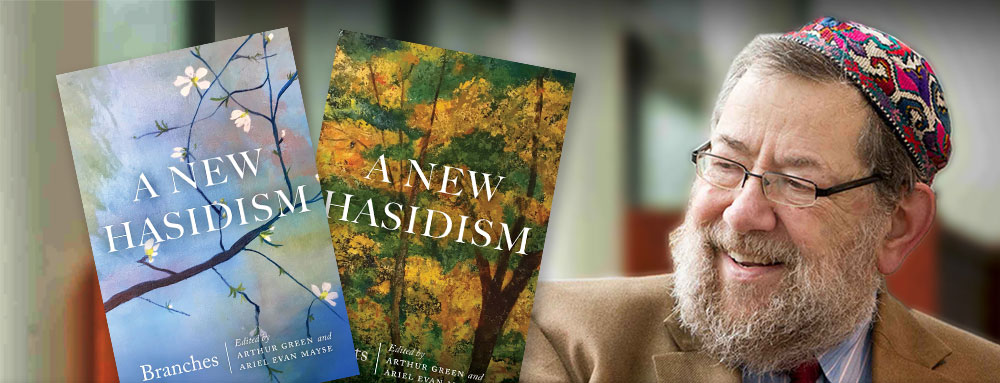Community Blog A New Hasidism

Hebrew College Rector Rabbi Arthur Green says Neo-Hasidism saved Judaism for him. In the course of a “crisis of faith” during his college years, he discovered Neo-Hasidism, a century-old approach to Judaism that applies the late-18th century Hasidic masters’ spiritual insights — of God’s presence everywhere, of seeking the magnificent within the everyday, of doing all things with love and joy, of uplifting all of life to become a vehicle of God’s service — to contemporary Judaism.
“One of my teachers gave me an essay by a Polish-Jewish thinker and poet named Hillel Zeitlin (he died on the road to Treblinka in 1942) called ‘Fundaments of Hasidism.’ I was 20 years old. I read that essay and it changed my life,” Rabbi Green said. “I had already lost my faith in the God of my childhood, and had begun to see myself as a non-believer. But Zeitlin didn’t begin with God, he didn’t begin with the Commandments, he didn’t begin with a sense of religious obligation. He began with ‘What does it mean to exist?’ and how to penetrate the mysterious core of existence, the inner oneness of being. He spoke in a mystical language that spoke to my own psyche. I knew I would speak that language for the rest of my life, and I would teach it. I was a spiritual seeker, and here I had found a depth and subtlety that I was looking for.”
Now Rabbi Green, 78, a renowned Jewish scholar and leading expert on Neo-Hasidism who founded the Rabbinical School at Hebrew College, has produced an unprecedented new two-volume work on the history and future of this approach, A New Hasidism: Roots and A New Hasidism: Branches, co-authored with his student, Stanford Professor Dr. Ariel Mayse. Hebrew College is honoring this work with a public day of study, reflection, and celebration on November 3. There will also be a similar event at the Manhattan JCC on December 8, and in California in spring 2020.
Over the course of his career, Rabbi Green has published more than a dozen works on Hasidism and Neo-Hasidism. But this newest work, Rabbi Green says, is different from his others. Rather than sharing his spiritual quest as a Jewish scholar and seeker, he looks at the history of the Neo-Hasidic quest itself, and offers a connection between the past and the present of Neo-Hasidism, between the original new-Hasidic students of the 20th century and seekers today. Together, the volumes represent Rabbi Green’s lifelong work as a Jewish scholar and seeker.
“My own theological writing for the last 30 years has been in the Neo-Hasidic spirit. But I never looked back and said, ‘Who are the Neo-Hasidic authors who influenced me? What has been the path of Neo-Hasidism since its inception?” Rabbi Green said. “We now have a generation of young people interested in this approach to Judaism, who never knew them. In some ways the connection to the old world of European Hasidism and European Neo-Hasidism is cut off. So I feel a great need to convey to these younger people what it is that the Hasidic sources themselves have to teach, and what these earlier Neo-Hasidic thinkers were trying to do. I see myself as living in a continuum of these earlier generations, and seeking to pass on their message.
The first volume, A New Hasidism: Roots, traces the origins of Neo-Hasidism in Europe between World War I and World War II and its recreation by immigrants from Europe in the United States in the 1960s, as well as Rabbi Green’s own life as a seeker in the 1960s and ‘70s. It includes an English translation of the Zeitlin essay that inspired Rabbi Green to explore Neo-Hasidism in college, as well as key writings by Martin Buber, Abraham Joshua Heschel, Zalman Schachter-Shalomi, and Shlomo Carlebach.
The second volume, New Hasidism: Branches, looks at what Neo-Hasidism might mean for the Jewish world today, as practiced by men and women who do not live within the strictly-bounded and segregated world of Hasidism, led by charismatic rebbes. In essays, Hebrew College faculty members Rabbi Ebn Leader, Rabbi Nehemia Polen, Rabbi Or Rose, Rabbi Jordan Schuster, and others discuss how to make this approach relevant in a society where, unlike the 18th Century Hasidic world, there is gender equality, interreligious discussion, respect for other traditions, and where people are “very suspicious of charismatic leaders.”
Green said that as a renewal approach, Neo-Hasidism can provide answers for young American Jews today, “who are asking: why continue to be Jewish? Why continue the tradition?” He hopes his new works provide a lens into this discussion.
“We live in a world where people learn from many different traditions, and to create a Judaism that is both independent and vital on the one hand and at the same time open to learning and open to sharing and respecting other traditions, other wisdoms, on the other, is a new challenge,” Rabbi Green said. “It seems to be a moment for looking forward in a new way. We need to awaken the spirit. A revitalization of the spiritual life is what Judaism needs and Hasidism knew how to do that. Hasidism can add a great deal to the Jewish experience even for people who are not living the traditional Hasidic life. Its message of joyous devotion and the possibility of seeking the divine presence throughout daily life is one that should appeal to many.”
Visit hebrewcollege.edu/neo-hasidism to learn more and register for “A New Hasidism: Study, Reflection, Celebration,” at Hebrew College on November 3, 2019.

